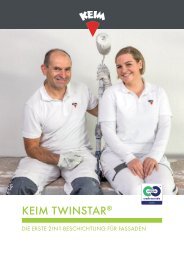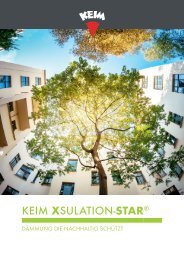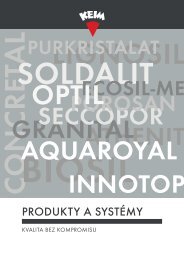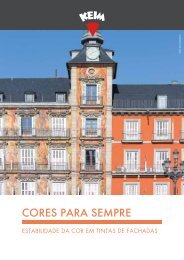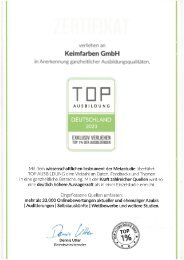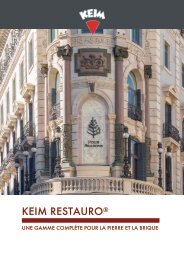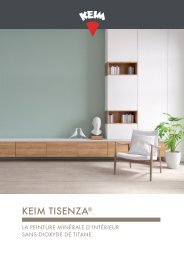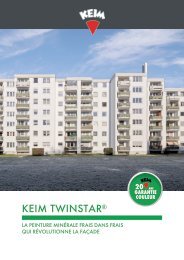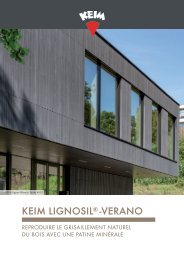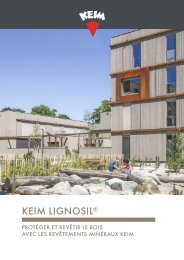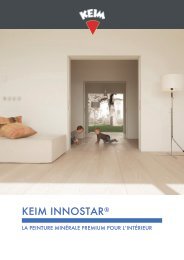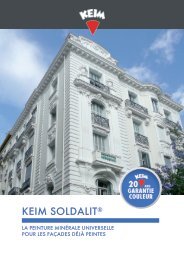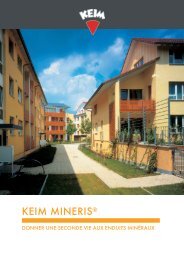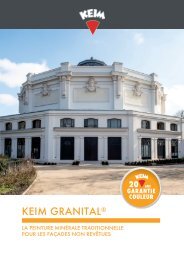KEIM "The shutter effect"
- No tags were found...
Create successful ePaper yourself
Turn your PDF publications into a flip-book with our unique Google optimized e-Paper software.
T H E "SHUTTER EFFECT" – COL O U R ST A B I L I T Y OF F A C A D E CO A T I N G S<br />
13<br />
COLOUR RESISTANCE –<br />
WHAT DO PAINTS ACTUALLY DO?<br />
Facade with clearly visible colour changes in the areas of dismantled <strong>shutter</strong>s.<br />
FIRST SYSTEMATIC INVESTIGATIONS<br />
INTO COLOUR CHANGE<br />
<strong>The</strong>re is no such thing as perfect colour stability, but<br />
there are still huge differences in the behaviour of<br />
coating products, something which practical experience<br />
teaches us time and again. If realistic statements are<br />
to be made, the only solution is outdoor testing in a<br />
true to life situation.<br />
<strong>The</strong> „iLF Forschungs- und Entwicklungsgesellschaft<br />
Lacke und Farben mbH“ (= Institute iLF for R&D of<br />
varnishes and paints) has carried out comparative<br />
outdoor weathering tests over eight years on five<br />
different exterior paints with different types of binder<br />
and assessed them in relation to colour change.<br />
<strong>The</strong> parameter investigated was the colour difference<br />
of the individual coatings after completion of eight<br />
years' weathering in comparison with an unweathered<br />
reference sample which had been stored in the<br />
laboratory protected from light and moisture.<br />
<strong>The</strong> assessment or measurement of colour difference<br />
also included an evaluation of pigment changes,<br />
binder changes, soiling and plant growth.<br />
Test products specified were a pure, two-component<br />
silicate paint, a silicate emulsion paint, a (silica-)sol/<br />
silicate paint, a lotus effect silicone paint and a pure<br />
acrylate exterior paint. <strong>The</strong> particular products tested<br />
were deliberately selected to be of the highest quality<br />
in their particular category.<br />
<strong>The</strong> colour shade selected was an intense blue<br />
(NCS S 2050-R80) because blue shades are particularly<br />
sensitive to weathering, and the human eye is<br />
particularly good at and sensitive in discriminating<br />
colour differences in the blue/grey range.<br />
Parallel outdoor weathering tests were carried out to<br />
DIN EN ISO 2810 in two different climates, one the<br />
industrial climate of Magdeburg and the other the<br />
rural climate of southern Bavaria. In this way, climatic<br />
conditions could also be taken into account, so additionally<br />
ensuring the general validity and practical<br />
relevance of the results. Both visual and instrumental<br />
methods were used for testing. All test methods were<br />
based on generally recognised standards.<br />
Left: 8 years of outdoor weathering test (2001-2009), “iLF Forschungs- und Entwicklungsgesellschaft Lacke und Farben mbH“ in Magdeburg




